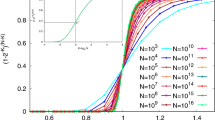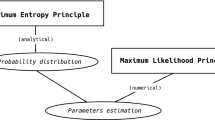Abstract
It is widely believed that for many optimization problems, no algorithm is substantially more efficient than exhaustive search. This means that finding optimal solutions for many practical problems is completely beyond any current or projected computational capacity. To understand the origin of this extreme ‘hardness’, computer scientists, mathematicians and physicists have been investigating for two decades a connection between computational complexity and phase transitions in random instances of constraint satisfaction problems. Here we present a mathematically rigorous method for locating such phase transitions. Our method works by analysing the distribution of distances between pairs of solutions as constraints are added. By identifying critical behaviour in the evolution of this distribution, we can pinpoint the threshold location for a number of problems, including the two most-studied ones: random k-SAT and random graph colouring. Our results prove that the heuristic predictions of statistical physics in this context are essentially correct. Moreover, we establish that random instances of constraint satisfaction problems have solutions well beyond the reach of any analysed algorithm.
This is a preview of subscription content, access via your institution
Access options
Subscribe to this journal
Receive 51 print issues and online access
$199.00 per year
only $3.90 per issue
Buy this article
- Purchase on Springer Link
- Instant access to full article PDF
Prices may be subject to local taxes which are calculated during checkout





Similar content being viewed by others
References
Cook, S. A. The complexity of theorem-proving procedures. Proc. 3rd Ann. ACM Symp. on Theory of Computing 151–158 (1971)
Cheeseman, P., Kanefsky, B. & Taylor, W. Where the really hard problems are. Proc. 12th Int. Joint Conf. on Artificial Intelligence 331–337 (1991)
Selman, B., Levesque, H. & Mitchell, D. Hard and easy distributions of SAT problems. Proc. 10th Nat. Conf. on Artificial Intelligence 459–465 (1992)
Kirkpatrick, S. & Selman, B. Critical behavior in the satisfiability of random boolean expressions. Science 264, 1297–1301 (1994)
Monasson, R., Zecchina, R., Kirkpatrick, S., Selman, B. & Troyansky, L. Determining computational complexity from characteristic ‘phase transitions’. Nature 400, 133–137 (1999)
Fu, Y. & Anderson, P. W. Application of statistical mechanics to NP-complete problems in combinatorial optimisation. J. Phys. A 19, 1605–1620 (1986)
Anderson, P. W. Solving problems in finite time. Nature 400, 115–116 (1999)
Gomes, C. P. & Selman, B. Satisfied with physics. Science 297, 784–785 (2002)
Monasson, R. & Zecchina, R. Statistical mechanics of the random K-satisfiability model. Phys. Rev. E 56, 1357–1370 (1997)
Mézard, M. & Zecchina, R. Random K-satisfiability: from an analytic solution to a new efficient algorithm. Phys. Rev. E 66, 056126 (2002)
Mézard, M., Parisi, G. & Zecchina, R. Analytic and algorithmic solution of random satisfiability problems. Science 297, 812–815 (2002)
Mertens, S., Mézard, M. & Zecchina, R. Threshold values of random k-SAT from the cavity method. To appear in Random Struct. Algorithms (in the press); preprint at http://arxiv.org/abs/cs.cc/0309020 (2003).
Appel, K. & Haken, W. Every planar map is four colorable. Contemp. Math. 98, (1989)
Achlioptas, D. & Moore, C. The asymptotic order of the random k-SAT threshold. Proc. 43rd Ann. IEEE Symp. on Foundations of Computer Science 779–788 (2002)
Achlioptas, D. & Peres, Y. The threshold for random k-SAT is 2k log 2 - O(k). J. Am. Math. Soc. 17, 947–973 (2004)
Friedgut, E. Sharp thresholds of graph properties, and the k-SAT problem. J. Am. Math. Soc. 12, 1017–1054 (1999)
Achlioptas, D., Naor, A. & Peres, Y. On the maximum satisfiability of random formulas. Proc. 44th Ann. IEEE Symp. on Foundations of Computer Science 362–370 (2003)
Bollobás, B. Random Graphs Vol. 73, 2nd edn Cambridge Studies in Advanced Mathematics (Cambridge Univ. Press, Cambridge, 2001)
Achlioptas, D. & Naor, A. The two possible values of the chromatic number of a random graph. Proc. 36th Ann. ACM Symp. on Theory of Computing 587–593 (2004)
Krzakala, F., Pagnani, A. & Weigt, M. Threshold values, stability analysis and high-q asymptotics for the coloring problem on random graphs. Phys. Rev. E 70, 046705 (2004)
Kirousis, L. M., Kranakis, E., Krizanc, D. & Stamatiou, Y. Approximating the unsatisfiability threshold of random formulas. Random Struct. Algorithms 12, 253–269 (1998)
Dubois, O., Boufkhad, Y. & Mandler, J. Typical random 3-SAT formulae and the satisfiability threshold. Proc. 11th Ann. ACM-SIAM Symp. on Discrete Algorithms 126–127 (2000)
Kaporis, A. C., Kirousis, L. M. & Lalas, E. G. The probabilistic analysis of a greedy satisfiability algorithm. Proc. 10th Ann. European Symp. on Algorithms 574–585 (2002)
Frieze, A. M. & Suen, S. Analysis of two simple heuristics on a random instance of k-SAT. J. Algorithms 20, 312–355 (1996)
Coppersmith, D., Gamarnik, D., Hajiaghayi, M. T. & Sorkin, G. B. Random MAX SAT random MAX CUT, and their phase transitions. Random Struct. Algorithms 24, 502–545 (2004)
Acknowledgements
We thank S. Kirkpatrick, J. Kleinberg and S. Mertens for feedback on the presentation of the results.
Author information
Authors and Affiliations
Corresponding author
Ethics declarations
Competing interests
Reprints and permissions information is available at npg.nature.com/reprintsandpermissions. The authors declare no competing financial interests.
Rights and permissions
About this article
Cite this article
Achlioptas, D., Naor, A. & Peres, Y. Rigorous location of phase transitions in hard optimization problems. Nature 435, 759–764 (2005). https://doi.org/10.1038/nature03602
Received:
Accepted:
Issue Date:
DOI: https://doi.org/10.1038/nature03602
This article is cited by
-
Tractability from overparametrization: the example of the negative perceptron
Probability Theory and Related Fields (2024)
-
One-Step Replica Symmetry Breaking of Random Regular NAE-SAT II
Communications in Mathematical Physics (2024)
-
Metastability of the Potts Ferromagnet on Random Regular Graphs
Communications in Mathematical Physics (2023)
-
Maximum feasible subsystems of distance geometry constraints
Journal of Global Optimization (2022)
-
The Satisfiability Threshold For Random Linear Equations
Combinatorica (2020)
Comments
By submitting a comment you agree to abide by our Terms and Community Guidelines. If you find something abusive or that does not comply with our terms or guidelines please flag it as inappropriate.



